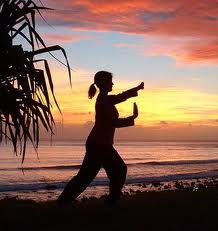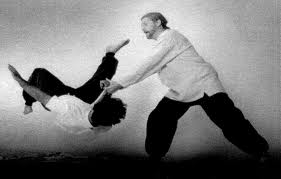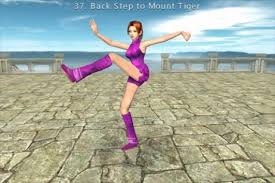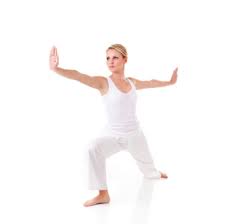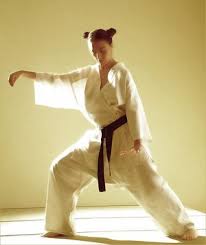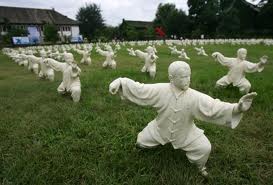In a twist odd even for modern Amerika, what is perhaps the most dangerous martial art in the world is now becoming widely considered to be a spiritual practice, comparable to yoga, or somehow related to it. Doesn’t that seem odd to anyone else?
(image of open-hand block and strike to solar plexus, a common Tai Chi technique)
From one standpoint, this development is the result of sophistry, a very effective psychological operations campaign, and greed. Let’s not fool ourselves on this issue, okay? The moves of Tai Chi are all designed to practice and perfect killing or crippling martial arts strikes. Tai Chi is a martial art. The goal and purpose of Tai Chi is to practice and perfect martial ability…the ability to kill or maim. The fact that the martial code reserves these actions only for defense of the self or of the defenseless does not change those facts.
The primary goals of Tai Chi are in direct opposition to those of yoga. Yoga is based on non-violence, on non-harming (number one in the ‘commandments’ of yoga, the yamas). Tai Chi is based on explicit violence. Every Tai Chi move is a deadly strike and/or block. If yogis were truly concerned with practicing a relatively non-violent martial art, I’d think they would be practicing Aikido (which is still a martial art, but one based on passive self-defense and re-directing an opponent’s energy, rather than on making overt and offensive strikes).
A common rebuttal of the inherently violent nature of Tai Chi is…the adherents only practice it for non-violent reasons, and the attitude in which it is practiced removes any martial component, rendering it a harmless and even spiritual mode of expression.
Consider this…
It is difficult (or impossible) to stroke a flower with a hammer in your hand.
If you want to stroke a flower (or perform non-violent movements and techniques as part of your spiritual expression), there is a practice designed specifically for that – yoga. Why are you wielding a hammer (or trying to learn that) if your goal is to stroke flowers? Why are you practicing a martial art if your goal is union, integration, and non-violence (the core tenets of yoga)?
Most proponents dodge this question by claiming they are not practicing Tai Chi Gung, but a non-violent version of Tai Chi (Tai Chi Chuan or one of the other, ‘peaceful’ derivatives). There are no non-violent versions of Tai Chi, okay? There are less potentially violent versions, made for beginners, to help prepare them and strengthen body and mind…in preparation for more advanced and deadly versions. All versions are martial. That fact is undeniable and inarguable.
The previous rationalization is like playing with toy guns and claiming a non-violent practice because they are not real guns…or like playing with small-caliber weapons and claiming it is not violent because A) they are not real big weapons and/or B) because the person is waving those guns around in praise, or with the goal of non-violent expression and energy movement. Either way, you are waving guns around…and claiming it is all non-violent.
The root causes for this travesty are obvious. As yoga practice increased in popularity in the U.S. and as martial arts popularity waned, a shift occurred. The martial arts craze (fueled by Bruce Lee and Chuck Norris movies, not to mention The Karate Kid) began to peter out, leaving a lot of mostly empty martial arts studios in strip malls all over America. The million-dollar-revenue ‘industry’ was in trouble. Simultaneously (or nearly so), a billion-dollar industry (yoga) burgeoned, filling those studios in ways martial arts never did. Yoga had become (is becoming?) a ‘boom industry,’ a ‘growth industry.’
Martial arts business owners could not help but notice this, nor the fact that Tai Chi alone seemed to still ‘draw’ students (and thus revenue), while the classes for more overtly violent and obviously martial styles decreased. Something had to be done!
The answer seemed to be a no-brainer…increase the marketing and class offerings of Tai Chi.
The slow and graceful movements of Tai Chi make it appear almost harmless, almost yogic, almost…non-violent. This makes it eminently more accessible and acceptable to the new crop of (ostensibly) non-violent consumers, who wish to use it as another form of exercise, expressive movement, or as part of a spiritual practice. Its contemplative and meditative aspects make it seem even more yoga-like (and thus more in alignment with a non-violent lifestyle and goals).
Once the practice of Tai Chi was ‘dumbed down’ (presented more as a subjectively interpreted expression rather than the performance-based martial art it is, with its attendant standards), it could suddenly be ‘taught’ by aerobics instructors and yoga teachers, by Pilates instructors and people who couldn’t fight their way out of a paper bag or explain (much less comprehend) the most basic tenets of this ancient martial art and its safe/effective practice, by people with little or no martial arts experience.
This elimination of standards and increased marketing of Tai Chi as a spiritual practice opened up a new potential market…and provided plenty of instant, pseudo-qualified teachers to capitalize on that new market.
Another root cause for the rise of this travesty-based application of Tai Chi is the greed of the consumers, of the new (and affluent but ignorant) market segment recently identified and targeted…is the desire of these consumers to follow consumer trends and to get the most bang (and variety) for their buck.
The existence of an ancient practice designed for non-violent spiritual expression and development (yoga) is simply not enough for the modern American spiritual-health fusion consumer. One real good chocolate chip cookie on the store shelf is not enough – consumers demand 87 types of cookies for their shopping pleasure.
A ‘mere’ yoga practice is not enough…consumers think they also need Pilates, expressive dance, somatic movement classes…and Tai Chi… to augment or complement their quasi-yoga practices. Excessive over-consumption is the American way, after all. If some is good, lots more is better, right?
And the health/spiritual industry merchants are more than glad to sell us variety…to get a slice of that huge yoga industry pie for themselves. Just dress up your martial arts or aerobics class in yoga clothes and…viola! increased class sizes and revenue, a revitalized market that was once dying (until it rode into the future on the coatyails of yoga, dressed in Prana tights and carrying a Manduka mat).
Of course this trend is also beneficial to most yoga instructors, scraping to fill their teaching calendars (and to make a ‘living’ or ‘career’ out of teaching yoga…or whatever sells). Simply read the Tao The Ching, attend a few classes at the local kwoon, and maybe scan a few books and movies. Now you are not only a yoga teacher, but a venerable and credible Tai Chi teacher. Your teaching schedule is filled, more revenue fills your coffers, and life is good, right?
Wrong.
This type of greedy, unconscionable action not only perverts the standards and ancient practice of yoga (by performing and promoting practices anathemic to it), but also perverts the ancient martial arts practice it misconceives and attempts to relegate to mere expressive physical movements and benevolent spiritual expression.
This type of sophistry and solipsism is rampant in our society, and thus the Tai Chi debacle is not a surprising development. This type of consumer-based, profit-driven mercantilism is also rampant, and dishonors both practices, misuses them, perverts them.
I understand how easily this can occur – how the good intentions of ignorant neophytes can be hijacked for profit. All parties surely perform these actions with what they see as pure motives, acting from the very best intentions.
Mine is not to judge or prescribe here – it is simply to observe and express thoughts and perceptions on the matter. If you want to simultaneously practice ancient schools with opposing goals and purposes, then by all means do so.
What boggles my mind is the desire to fool ourselves about it, to somehow get ourselves to see Tai Chi as non-violent, to convince ourselves that this eminently martial practice is somehow spiritual as well, to have the ignorance and audacity to ignore or dismiss the obvious martial nature and aspects of Tai Chi, to rationalize it into some warm and fuzzy dance that fits with our espoused non-violence paradigms.
I can understand a person who notices the incongruency and chooses to practice these opposing systems in spite of the dichotomy, because they choose to for their own reasons, whatever they are. I have a harder time understanding someone who pulls the wool over their own eyes, who ignores the obvious facts and history surrounding the issue, and instead chooses to try and convince us all that it’s all about love and spiritual light.
Maybe their bullshit detectors don’t work, but mine sure does.
Why even try to stroke a flower with a gun in your hand? Why try to front the anomalous supposition that an internal state of peace is enhanced by external gestures of martial violence? Why throw punches and tell me they are not really punches because you fail to see them as such, or insist on calling them something else?
It’s a perplexing trend, to say the least. These good people truly do not see any contradiction, do not sense the hypocrisy. They truly believe their Tai Chi practices have nothing to do with martial arts or violence, when all evidence shows otherwise, given the slightest amount of research, consideration, or experience.
Sometimes words cannot convey what is so obvious in pictures. Here are some of the common Tai Chi techniques (most of them have innocent sounding names like ‘grasping the bird’s tail,’ belying the real nature of what the technique is):
Back step to mount tiger.
LOL, breaking neck with palm strike is more apt…or kicking opponent in the head. At best, rising wrist block (which is also painful and violent, as you’d know if someone ever used this technique on you).
Here’s a technique that looks (on the surface at least) like the yoga pose Virabhadrasana 2 (Blessed Protector Pose, most often mis-translated as Warrior Pose, perhaps due to its ostensible martial posture). Hmm…dual palm strikes to the sternum (or jaw). Nothing violent about that, right? Proponents may argue that, regardless of the possible application, her intention may be simply to move and extend energy. The yoga pose is designed to move and extend energy in non-violence, while the Tai Chi technique is designed to move energy for violent purposes, regardless of what you intend or feel while performing it. As a yogi, which pose would be more appropriate, which would be more in alignment with the lifestyle you want to live, with the person you want to be?
Here’s one that is indistinguishable from most basic Karate or Gung Fu forms…the ubiquitous palm strike to the chin or philtrum (base of nose). If performed as intended (and practiced in Tai Chi), it will break the opponent’s neck and paralyze or kill them (chin strike application), or simply drive cartilage into the brain and kill them (nose strike application). Pretty spiritual, eh? Who cares if you see it as ‘pushing away negativity…you are still practicing a move designed for violence.
This woman is dressed in a traditional martial arts gi, performing a traditional martial arts combination of strike and block (or dual block – dual strike). You can see the love on her face, almost feel the Ghandi-like non-violence shining from her, can’t you? I wonder what her intention is… The semi-transparent nature of the uniform, the breast in profile, and the sun shining down seem to not only attempt to spiritualize Tai Chi, but also to sexualize it.
I could go on and on in this vein…the techniques are so obviously martial, they need no interpretation or explanation. Any first grader could tell you these are ‘karate moves,’ not ‘yoga moves.’ So why would anyone choose them?
I guess I am fascinated by the sophistry, amazed at the things people can convince themselves of despite contrary evidence. I suppose I’m a bit mystified by an ostensibly peaceful New Ager waving their arms around in a parody of martial techniques, firmly convinced that they are engaged in a peaceful, non-violent ‘spiritual’ practice.
Can anyone help me understand that better?
I spent many years practicing Tai Chi and various martial arts forms. I practiced on beaches, mountaintops, in deserts. I devoted myself to learning the fundamentals, history, and applications of Tai Chi and the path of the warrior. I was aware of the meditative and Zen-like aspect of the practice, but also of the roots in violence. It was no contradiction then, since I hadn’t truly entered or deepened my yoga practice then.
I knew that Tai Chi and the other martial arts were based on violence (albeit theoretically controlled violence). Once I truly began a practice based on non-violence, I naturally dropped the sword, since the violence of martial arts was anathema to yoga.
I fully support all people on their path, and realize that many (like I) need to pick up the sword before they can truly drop it, that each walks a path none other can judge. I realize that these paths often take us through strange places, along routes that seem at odds with our goals.
That’s all good – I can allow that for myself and others, be gentle and accepting of this human tendency.
I suppose I do rebel a bit at someone trying to sell me (or themselves) wooden nickels, though.
What do YOU think?
How and where do you find success in integrating a martial practice with a non-violent life? Where do you see paradox in this trend?
Rather than merely spout my own thoughts on this issue (which I already know), I’d rather have my ignorance lifted or my perspective expanded, perhaps even by one of the enlightened proponents of violence-based practices.
I hope this post provoked thought and reaction. I hope it increases consideration and mindfulness. I hope it gives rise to non-violent, productive dialog. I am an optimist, of course. If you find it worthy, please like this post and share it with your friends. If you feel inspired to, please share your comments (from either viewpoint). And look for an upcoming related post, from the standpoint of a proponent of this trend.
Thanks for reading! : )
